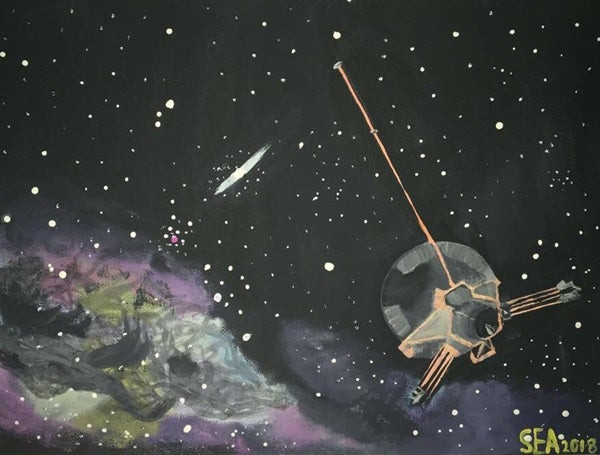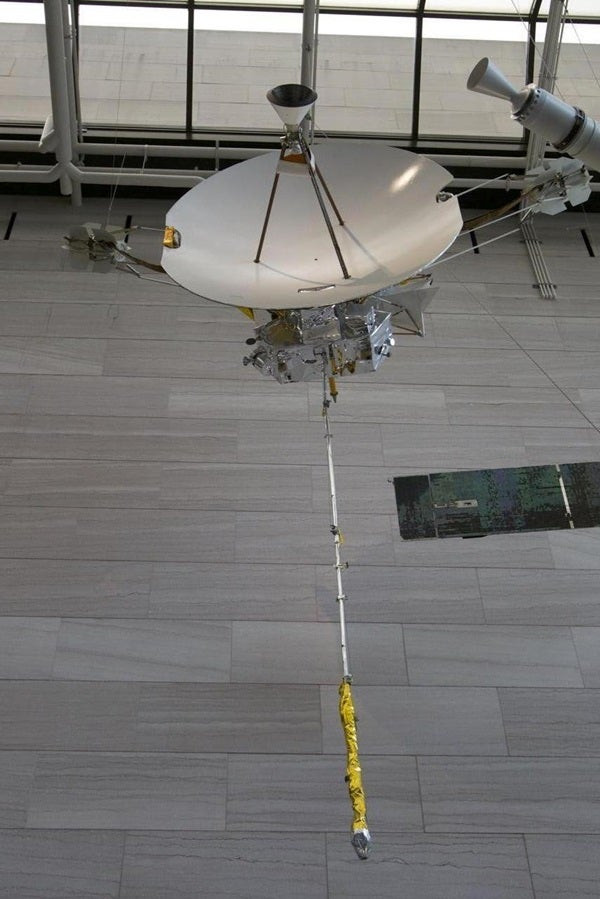Pioneering the outer reaches of our solar system, the Pioneer 10 and 11 spacecraft were trailblazers, venturing into uncharted cosmic territories long before Voyager and New Horizons. Launched in 1972 and 1973 respectively, these missions, managed by NASA, achieved unprecedented feats. They were the first to successfully navigate the asteroid belt and provided humanity’s initial close-up encounters with Jupiter (both Pioneer 10 and 11) and Saturn (Pioneer 11). Mirroring their Voyager successors, both Pioneers are now far beyond Pluto’s orbit, continuing their outward journey from the Sun’s gravitational influence, carrying with them a legacy of discovery and a perplexing scientific enigma known as The Pioneer Anomaly.
 Painting of the Pioneer spacecraft in deep space
Painting of the Pioneer spacecraft in deep space
Artistic representation of the Pioneer spacecraft traveling through deep space, highlighting its mission to explore the outer solar system and beyond.
Powered by robust radioisotope thermoelectric generators (RTGs), each Pioneer spacecraft was equipped with a suite of scientific instruments. These tools enabled them to capture images and meticulously measure the environments surrounding Jupiter and Saturn, as well as the conditions prevalent in the outer solar system. Adding a touch of human outreach to their scientific endeavors, the Pioneers also carried the iconic Pioneer plaque. This plaque served as a symbolic message, a pictorial greeting card intended for any extraterrestrial civilizations that might one day stumble upon these emissaries from Earth, detailing our origins and our place in the cosmos.
What set the Pioneer missions apart was not only their exploratory ambition but also their exceptional design for precise tracking. Both Pioneer 10 and 11 were spin-stabilized, a technique that involves rotating the spacecraft around a central axis to maintain stability and trajectory without frequent corrections. This spin stabilization, combined with advanced transceivers and ground-based Doppler tracking technology, allowed for incredibly accurate measurement of their acceleration, down to an astonishing precision of approximately 10–10 meters per second squared (m/s2). This level of tracking accuracy surpassed that of the Voyager missions, which, lacking spin stabilization and relying on more frequent thruster firings, were not traceable to the same degree of precision.
 PioneeratNASM
PioneeratNASM
Pioneer H spacecraft on display at the National Air and Space Museum in Washington, D.C., showcasing the design and engineering of the Pioneer series.
The Emergence of an Unexplained Deviation
The unparalleled precision in tracking the Pioneer spacecraft led to an unexpected and intriguing discovery: the Pioneer anomaly. As the Pioneers journeyed further from the Sun, scientists anticipated a gradual deceleration due to the Sun’s gravitational pull. While it was understood that the spacecraft had achieved solar escape velocity and were on a trajectory to leave the solar system, by 1980, an anomaly began to surface. Researchers at NASA’s Jet Propulsion Laboratory (JPL) observed that both Pioneer 10 and 11 were slowing down at a rate slightly greater than predicted by established physics. This deviation manifested as a small but persistent sunward acceleration, measured at 8.74 ± 1.33 × 10−10 m/s2.
Although seemingly minute, this discrepancy had significant consequences over time. It caused the Pioneers to lag thousands of kilometers behind their predicted positions each year. This unexplained deceleration became a profound puzzle, captivating the scientific community and prompting intense investigation. The fact that even such a small, anomalous acceleration could not be accounted for by known gravitational forces raised fundamental questions. Some even speculated whether this anomaly hinted at a potential flaw in our understanding of gravity as described by Einstein’s theory of general relativity.
The Pioneer anomaly ignited widespread scientific curiosity and debate. Researchers explored a multitude of potential explanations for this unexpected deceleration. Could it be attributed to subtle gravitational influences from the interstellar medium, the sparse matter and radiation that permeates the space between stars? Was interplanetary dust creating an imperceptible drag on the spacecraft? Could solar radiation pressure be exerting an unaccounted-for force? Were there inaccuracies in the calculations of Earth’s precise position relative to the spacecraft? Or, perhaps, was the anomaly originating from the spacecraft itself – possibly due to waste heat emission, a minor malfunction in a thruster, or a slow gas leak?
Addressing the Pioneer anomaly was not only a theoretical challenge but also a practical one. The vast amount of technical data from the Pioneer missions, crucial for unraveling the mystery, was archived on outdated media: paper records and 7- and 9-track magnetic data tapes. Locating these data sources, some of which were in precarious storage conditions, and retrieving the obsolete hardware required to read these tapes presented a formidable obstacle. Converting this legacy data into modern digital formats was a labor-intensive and costly endeavor. Organizations like The Planetary Society stepped in to provide crucial funding, supporting researchers like Slava Turyshev and his team in their arduous quest to recover and analyze the historical Pioneer data.
 Pioneer_Anomaly_stairs_data_tapes_3
Pioneer_Anomaly_stairs_data_tapes_3
Archival photograph showing stacks of 7- and 9-track magnetic tapes containing valuable data from the Pioneer missions, highlighting the data recovery challenges.
Thermal Recoil: The Solution Emerges
Among the various hypotheses proposed to explain the Pioneer anomaly, one explanation consistently stood out: thermal effects, primarily stemming from the heat generated by the four RTGs aboard each spacecraft. To rigorously investigate this possibility, Turyshev and his colleagues, notably Viktor Toth, embarked on a detailed analysis. They meticulously constructed a highly accurate thermal model of the Pioneer spacecraft, incorporating both predicted and actual thermal measurements.
Their analysis began by modeling the heating effects from the Sun on the trailing face of the spacecraft. They then turned their attention to internal heat sources, particularly the RTGs. The heat radiated from the RTGs was directed towards the leading edge of the spacecraft, aligning with its direction of motion. Similarly, heat emanating from the electronics box also predominantly radiated in the same forward direction. This directional heat emission generated a subtle, but cumulative, sunward pressure on the spacecraft. The team’s comprehensive thermal model revealed that the overall heating of the spacecraft, when all contributing factors were considered, was indeed asymmetric.
Ultimately, Turyshev and his team reached a compelling conclusion: radiation forces resulting from the differential heating of the spacecraft, known as thermal recoil forces, originating from the RTGs and electronics, were sufficient to fully account for the Pioneer anomaly. Further supporting this thermal explanation, subsequent analysis indicated that the anomaly’s magnitude appeared to diminish over time. This decrease was consistent with the expected radioactive decay and gradual decline in power output of the RTGs, lending further credence to the thermal recoil force theory.
In the end, the Pioneer anomaly, once a perplexing challenge to our understanding of physics, was resolved through meticulous investigation and innovative analysis. General relativity remained unchallenged, and our fundamental understanding of physics remained robust. The story of the Pioneer anomaly serves as a powerful reminder of how precise scientific measurements can unveil unexpected phenomena, challenge established paradigms, and drive the development of new approaches to solve complex scientific puzzles. It underscores the dynamic nature of scientific inquiry, where anomalies are not necessarily failures, but rather opportunities for deeper understanding and advancement.

